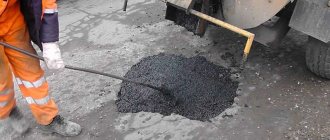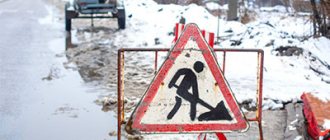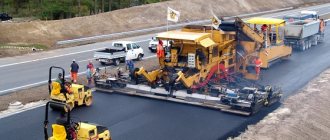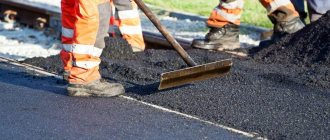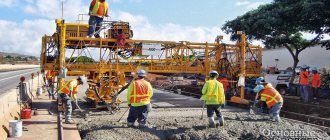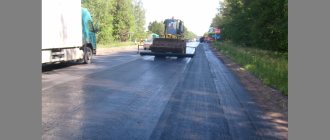Asphalt pavement is the most reliable and common way to block or repair the road surface. The laying process itself is possible both manually for small amounts of work, and using specialized equipment.
Asphalt pavement is the most common road surface, reliable and durable.
The use of rollers or asphalt pavers will allow you to achieve maximum quality in your work.
The most common type for asphalt is a crushed stone base, but laying on a concrete base is also possible.
Asphalt concrete coatings have the highest wear resistance and resistance to various climatic influences. Laying asphalt is the final stage of the entire technological process of road surface repair.
First of all, the organization of work begins with the arrangement and stabilization of the soil.
Technical requirements
Laying asphalt is a complex technological process that requires experience and literacy. Before starting road work, you need to familiarize yourself with a number of guidance documents, instructions for performing the work, as well as GOSTs. Below are some of them:
- GOST 7473-85 - describes what requirements or technical conditions should be adhered to when producing concrete mixtures;
- GOST 9128-97 - describes the standards for various asphalt concrete airfield and road mixtures;
- GOST 28013-89 – contains standards for the production of mortars;
- GOST 30412-96 – contains a description of methods and means for measuring slopes and unevenness of airfield and highway roads;
- GOST 30413-96 – created for highways and contains a method for determining the coefficients of adhesion between car wheels and the road surface.
In addition to the above regulatory documents, it is important to study the CMEA standardization, which describes general norms and requirements for highways. If construction rules are violated at any stage, the laid asphalt will quickly crack and unevenness may form on the asphalt surface.
Coating materials
Installation of asphalt on a concrete base.
The choice of material for laying asphalt can greatly affect the cost of the entire process. But it is worth noting that saving on material is not always good.
There are modern building mixtures that can significantly strengthen the soil, which will increase wear resistance and significantly increase the service life of the asphalt pavement.
Due to the components from which such materials are produced, the mixture reliably glues soil particles together, making the soil hard with a rocky structure.
Before pouring the concrete mixture onto the ground, you need to perform several steps:
- The entire vegetation layer is removed from the soil surface, and the soil is compacted with a roller weighing 1.5-2 tons. The soil surface should be fairly level, with a maximum slope error of 2.5 cm for every 3 meters.
- It is advisable to treat the soil with special sterilizing agents to prevent the germination of any plants.
- Under the concrete, it is mandatory to lay a drainage layer of sand and crushed stone, each of which must be at least 10 cm thick. The cushion of sand and crushed stone is also carefully compacted. For better shrinkage, you can spill the base with water over its entire area. It is important to achieve 95% sand compaction.
Paving technology
The final stage is laying asphalt, which is thoroughly mixed with fine sand and stone flour. This mixture is heated to the desired temperature and laid in layers. Each of them should be approximately seven centimeters thick. An asphalt paver is used during the laying process. This serious equipment is equipped with many sensors and its own computer. Upon completion of the process, the finished coating is again watered with bitumen emulsion.
- Hot type coatings. They are laid at temperatures above 140 degrees. This requires special equipment. Hot asphalt pavement is highly durable, so it is used for laying roads, city streets and squares.
- Cold asphalt. This type of mixture is also called warm, and it is prepared using bitumen, which has a reduced viscosity. Cold material is laid at a temperature of 80 to 120 degrees. Asphalt coatings of this kind are most often used in courtyards, playgrounds, sidewalks and other places that are not subject to heavy loads.
Features of the work
Before you start pouring concrete, it is worth taking a number of measures to create a waterproofing layer on top of the sand and crushed stone base.
Scheme of the design of the roadway and sidewalk with asphalt surface.
- To create the strength required for asphalt, concrete must be reinforced. The frame for pouring is usually made from class A-III reinforcement or from a special mesh for road work.
- The concrete itself is poured with a thickness of at least 8 cm. To ensure surface drainage for liquids, the concrete base is poured with a certain slope from the center to the edges in the region of 2-3 mm per m.
- Upon completion of pouring, the concrete base must be tested for the formation of puddles. The maximum depth of puddles formed when filling the surface with water should be no more than 1.5 cm.
- Laying asphalt over a base that does not meet these requirements will be more difficult to level. Puddles that appear during the operation of asphalt pavement quickly destroy the surface.
- Asphalt is directly laid on the surface (concrete). As a rule, this work should be carried out in good weather conditions. The presence of moisture on the surface of the base significantly reduces the temperature of the asphalt.
- Basically, due to the difference in the thermophysical properties of asphalt and concrete, in order to avoid the occurrence of cracks in the future, the temperature of the topmost layer should be as high as possible and reach 175 degrees.
Moreover, the asphalt coating is compacted by a roller only some time after it has been evenly distributed over the surface.
There is a technology for laying hot asphalt in its molten state. When using the casting method, the road surface can be repaired even in winter without rolling or tamping. The asphalt itself is applied in the thinnest layer.
If installed correctly, asphalt will last for many years, and the accident rate on such a surface will be significantly lower.
The asphalt surface must provide the necessary smoothness of the road.
This article explains what an asphalt pavement is and in what cases the use of single-layer asphalt is justified.
Asphalt is a mixture of various resins and bitumen - asphalt with filler - sand, gravel, crushed stone and various additives that change the properties of the finished mixture. Due to the large amount of bitumen, when heated, asphalt concrete is plastic, compacts well, and after hardening it acquires strength and wear resistance. Properly made asphalt roads last for decades.
Asphalt concrete mixture is a mixture of various resins and bitumens.
How is asphalt road surface constructed?
Asphalt is the top part of the road surface. In order for asphalt to serve for a long time, it is necessary to prepare a high-quality base. Crushed stone of different fractions, broken brick or concrete are used as the base. The base ensures drainage of rain and groundwater and distribution of pressure on the coating over as large an area as possible. The base is used to level out uneven ground to prevent the formation of bumps and holes. The thickness of the asphalt pavement directly depends on the base and expected operating conditions. If the base is made of crushed stone or broken brick, then the thickness of the asphalt will have to be increased, because compacted crushed stone does not have the necessary rigidity. If concrete is poured on top of the crushed stone base, providing the required rigidity of the coating, then the asphalt layer can be made smaller.
The road surface consists of two parts: the lower part - the base and the upper part - the asphalt.
Working with asphalt
Asphalt work can be divided into three main categories: construction, repair and overlay replacement.
Construction
During the construction of the road, a foundation is laid, which is redone only during major repairs. If the base is made with high quality, then the current repair will be reduced to updating the asphalt surface by patching and laying a thin layer of asphalt on top. If the foundation is made with errors, then an attempt to correct the situation by replacing or increasing the asphalt layer will not yield anything. You will have to completely remove the asphalt layer, remove the upper layers of the base, and try to fix the lower ones. Often, building a new road is cheaper than such repairs.
Repair
The purpose of repair is to bring the road surface into proper condition. Depending on the damage to the pavement, patching, laying a new road surface, or completely replacing the top layer of the road surface are used.
Replacing the top layer
Sometimes it is necessary to replace the top layer of the road surface. For example, concrete does not tolerate temperature changes well, it is cracked and dusty. Or paving slabs irritate women wearing high stiletto heels. As a result, the top layer of coating has to be changed. In the case of laying asphalt on an old concrete road, a thick layer is not required. Unless there will be heavy trucks driving on the road. Expansion joints are cut into the concrete and covered with asphalt. If the old covering is made of paving slabs, then the slabs are removed, the base is leveled with sand, and covered with asphalt.
What determines the required thickness of asphalt?
The required thickness of asphalt depends on two factors - the load on the asphalt and the rigidity of the base.
One layer of asphalt
This thickness of asphalt is applicable for pedestrian paths where cars occasionally enter, for example, parking lots in front of small shops. One layer of asphalt is also used for roads with a concrete base on which only passenger vehicles move.
Two layers of asphalt
This thickness of asphalt is applicable for roads along which passenger vehicles move, and the base of which is made of broken brick or crushed stone. Parking lots near large stores and in parking lots are most often made with two layers of asphalt. When laying two-layer asphalt on a concrete base, the strength of the road surface is sufficient for the movement of light trucks and buses.
Three layers of asphalt
A road surface with three-layer asphalt and a base made of broken bricks or crushed stone with a thickness of at least thirty centimeters is suitable for busy intercity highways, and the movement of any vehicles except heavy trucks on them.
Asphalt in four layers or more
Suitable for roads with heavy traffic of any vehicle. With such a thickness of asphalt, a concrete base does not have any advantages over a base made of crushed stone of 4-5 different fractions.
Laying a thick layer of asphalt is suitable for roads with heavy traffic.
- For repairing damaged multi-layer asphalt pavement that does not have deep (more than one layer of asphalt) damage.
- For decking on top of a concrete base, this will allow the road to be used for passenger vehicle traffic.
- For pedestrian paths.
Laying a thin layer of asphalt for pedestrian paths.
The thickness of asphalt directly depends on the operating conditions of the road.
Asphalt road surfaces are common and extremely popular. This is due, first of all, to the durability and strength of this option. For these conditions to be fully met, a number of conditions must be met. The technology of laying asphalt has certain difficulties, but if everything is done correctly, the costs will be recouped with impeccable coverage and trouble-free operation.
Layers of asphalt
According to technical and economic requirements, asphalt pavements are usually divided into appropriate layers. Let's look at each of them.
- Asphalt surface (about 50 mm). As the top layer of a road, the asphalt surface is directly exposed to stress and weather. Due to high mechanical and climatic influences, they must usually be replaced after 12-15 years. Special aggregate additives help optimize their durability.
- Layer of binder asphalt (about 80 mm). The main function is to quickly and effectively remove shear forces and vibrations from the road surface in the lower layers. In this way, it protects the outer layer, especially under high load and heavy braking, from overload and distortion.
- Asphalt base layer (approx. 220 mm). The base layer of asphalt serves to distribute high loads and distribute them evenly on the lining. This is a homogeneous and stable surface for subsequent layers. The bottom layer of asphalt is the most important. Thanks to the coarse-grained rock mixture, it ensures uniform load distribution, which increases the load-carrying capacity of the road. If the road is well maintained, the base layer can last up to 50 years.
- Protective layer to prevent freezing of asphalt (approx. 340 mm). To prevent damage caused by frost, a frost protection layer is often used underneath layers of asphalt. Unbound gravel, sand or crushed stone is extremely heat resistant, water penetration occurs quickly and prevents frost corrosion in the upper layers of asphalt.
Types of asphalt pavement
In the production of asphalt mixtures, bituminous materials (resins), as well as reinforcing filler, are used. Its role is played by coarse sand and mineral rocks of a certain fraction. All materials must be of good quality, and depending on the type and purpose of the coating, other ingredients are added to the composition.
Types of asphalt:
Proportions and manufacturing standards are regulated by GOST, but many manufacturers ignore this rule and use cheap substitutes. This does not reflect well on the quality of the asphalt mixture, so it is preferable to order this product from truly trusted companies, for example, representative offices.
Application technologies:
- Hot asphalt. Its installation technology requires the use of special equipment, as well as compliance with a number of conditions. First of all, this is the temperature of the finished mixture and the ambient air. It is unacceptable to lay cooled asphalt, or to carry out work at sub-zero temperatures. The second important point is the speed of laying hot asphalt. If the work is not performed in accordance with GOST, the quality of the coating will be poor. Hot asphalt is used to lay new roads and sidewalks. After application, the coating should not be used for some time to ensure sufficient adhesion.
- Cold asphalt. Its standards are also regulated by GOST and SNIP, but in production other grades of bitumen are used, which harden faster and do not require a certain temperature. Cold asphalt can be laid in a wider range of ambient temperatures (up to -5ºС is allowed). Most often, this method is used when performing pothole repairs of roads, or to perform asphalt paving on your own.
You can purchase cold asphalt not only directly from the manufacturer, but also in construction stores. Airtight containers allow you to preserve its characteristics for up to several months. At the same time, in terms of strength and service life, the cold mixture is significantly inferior to the alternative option, so the use on busy roads or places of active use is somewhat limited.
How thick should the asphalt be?
Depending on the thickness and position, the different layers contribute to the stability of the road. It is important that the top layer is at least 50 mm.
In addition to the standard mixtures that meet the technical requirements of asphalt road construction, there are also special asphalts such as porous, semi-rigid layers, etc. In a nutshell, it can be seen that asphalt along with modern paving technology serves excellently because it does not Not only is it durable, but it is also efficient and environmentally friendly.
Preparatory work before laying asphalt
An important condition for proper installation is compliance with the requirements of GOST and SNIP for surface preparation. These standards provide for several stages, on which the quality of the future road will also depend.
How to prepare the surface:
GOST for laying asphalt regulates all possible nuances associated with the implementation of such a coating. This process is complex, because even with special equipment, most of the work still requires manual labor.
Popular about asphalt laying technology
The work itself begins with a device, the so-called earthen trough. New asphalt pavement should generally be flush with the rest of the surface, so all layers of crushed stone and asphalt should go deeper. Therefore, throughout the entire territory, soil is selected to a depth equal to the total thickness of the future coating. After the soil has been selected, it is advisable to compact the bottom of the trough by walking over it with a road roller or vibrating plate.
Landscaping is a serious matter. And although it will almost certainly be asphalt concrete specialists who will be paving your yard, it will be useful for you, as the owner-customer, to familiarize yourself with the basics of asphalt laying technology in order to assess the professional level of your contractors and to simply navigate the process.
How is asphalt paving done?
The rules for laying asphalt mostly depend on the type and purpose of the coating, but some standards cannot be changed. Such rules are clearly stated in GOST and SNIP, and they ensure the durability and quality of future roads and sidewalks.
According to GOST requirements, asphalting of roads and sidewalks must be carried out under suitable weather conditions. The production of the mixture is also determined by the standards of these documents. Laying asphalt SNIP (building codes and regulations) also determines the quality of the finished work, from the stage of preparatory work to the final cycle.
Basic requirements of the standards:
Modern additives - plasticizers allow installation even at sub-zero temperatures. This mixture is called asphalt concrete. It is quite expensive and is most often used for emergency road repairs in winter.
How to choose the thickness of asphalt pavement when paving
Asphalting roads is a complex and labor-intensive process. Before starting work on laying asphalt, it is necessary to correctly determine the operating conditions of this surface in the future, and depending on this, determine the optimal thickness of the asphalt pavement. In our country, 80% of highways are located in a zone of unfavorable climatic conditions - sharp temperature fluctuations, high humidity, deep freezing of the soil, all this negatively affects the asphalt and reduces its service life. It is for this reason that when laying asphalt it is necessary to ensure the correct technology, including the correct thickness.
First of all, it should be noted that laying asphalt in the courtyards of private houses, in parking lots and on public roads should be done using different technologies. The service life of a road surface primarily depends on its operating mode: how many cars will travel along the road every day, what the speed limit will be, and whether trucks and buses will move along this section. The correct choice of asphalt thickness depends on all these factors.
Paving the site of a private house
The coating near a private house does not have to be very thick, because this area is not intended for moving a large number of vehicles and other equipment. At the same time, GOST sets the minimum thickness of asphalt for pedestrian areas and courtyard areas at 40mm (4cm). If you try to save too much and carry out asphalt paving with too thin a layer, after the very first winter this surface under the influence of frozen groundwater may crack and become unusable.
In addition, laying asphalt near a private house must be carried out in accordance with all the procedures prescribed by building codes, with the obligatory leveling of the site, adding sand and crushed stone under the main layer.
Asphalting of car parks
In the area of car parks and parking spaces, asphalt must be laid with a thickness of at least 60mm. This is important because, regardless of the parking capacity, sections of asphalt will be subject to increased load even from statically standing cars. This is especially true for parking lots near shopping centers and other popular places, where the daily volume of traffic may not be much less than on a busy road. Increased demands are placed on both road alignment and the thickness of the sand and crushed stone layer under the hard surface.
Laying asphalt on highways
The requirements for asphalting roadways are even higher. The minimum thickness of the asphalt layer here is established according to GOST starting from 80mm (8cm), but in the case of construction of a busy highway, with active movement of heavy vehicles, it can be increased to 10cm. In addition, asphalting roads should be carried out in several layers: on top of the first layer of asphalt 4-8 cm thick, after it has hardened, a layer of asphalt mixed with gravel and small crushed stone, another 4-6 cm thick, is applied. Moreover, to increase the durability of the pavement, some companies also use a special cement layer under the asphalt, so that the road can be used without repair for many years.
Thus, the thickness of the asphalt should be:
- for sites of private houses - at least 4 cm;
- for parking lots - at least 6 cm;
- for roadways - at least 8 cm.
In addition, it is important not only to control the correct thickness of the asphalt layer, but also the paving company’s compliance with the entire asphalt paving technology.
Final works
After asphalting, a special impregnation must be applied to the section of the future road. It provides tight adhesion to asphalt and gives the coating an attractive appearance.
The following impregnation options are distinguished:
When choosing a finishing layer, it is worth considering not only the financial issue, but also the main purpose of the project. When choosing a mixture, you need to take into account how intensively the road surface is used.
Creating asphalt pavement is an important process, because it determines the quality and durability of future roads and sidewalks. The classification of mixtures and the application process are determined by the requirements of GOST and SNIP, as well as the types of road work. In order for the coating to last as long as possible, even under intense load, it is important to choose a reliable one that guarantees speed of execution and compliance with all quality requirements.
Asphalt coating is considered one of the most popular and durable. This is an excellent method to repair a road or make a new road layer. The technology for performing this process is of two types - manual and using special construction equipment. If the scope of work is not too extensive, then using the first option is preferable.
Crushed stone mixture is used as a base for concrete asphalt. However, this is not necessary; such a mixture can be replaced with a concrete base. Asphalt of this type is characterized by some of the highest strength, durability, and ability to withstand the effects of atmospheric phenomena. Laying such a coating is the last point in the production process for repairing highways and roads.
Before starting the main process, it is worth carrying out organizational and preliminary work. These also include arrangement of the work site and soil stabilization.
Technical requirements
The technological process of laying defense asphalt is not as simple as it might seem at first glance. Such work requires skills, experience and knowledge. Before you begin laying or repairing the road surface, you need to study the necessary manuals, documents, instructions, and GOSTs. The following are only the main GOSTs:
- GOST 7473-85. This document describes the necessary rules, requirements and technical nuances. It is these standards that must be taken as a starting point during the production of concrete solutions.
- GOST 9128-97. This document provides requirements for different types of concrete solutions used for highways and airfields.
- GOST 28013-89. This document provides requirements for the production of asphalt concrete solutions.
- GOST 30412-96. This document describes methods and materials for accurately measuring slope and roughness angles for public roads and airfields.
- GOST 30413-96. This document was written directly for public roads; it describes a method for finding the indicator of adhesion between the wheels of cars and the road surface.
However, it is necessary to study not only the above-mentioned manuals, but also pay attention to the standardization of CMEA
. It specifies the general requirements and parameters of public roads. If you do not comply with the requirements specified in the documentation, then this risks the fact that the installed coating will soon become covered with cracks, and unevenness will appear on the surface.
Coating materials
Laying asphalt pavement on a crushed stone bed.
It is difficult to overestimate the importance of materials. After all, the economic side of the technological process primarily depends on their choice. It is important to know that it is not always wise to save on materials.
The market offers customers a huge assortment. Nowadays you can easily purchase a solution that can strengthen the soil well, which will affect its durability and strength. The consumer will be able to use the road surface for a longer time. Thanks to its special composition, the solution glues soil particles together, and this makes the soil strong and like stone.
Before pouring the concrete solution onto the soil, it is important to carry out some preliminary manipulations:
- Plants must be removed from the top layer of soil, and the soil must be compacted using a roller. It is better to use a roller that weighs at least 1.5 tons. The soil surface must be extremely smooth, the permissible maximum error of the slope angle is no more than 3 centimeters for every three meters.
- It is recommended to treat the soil with specialized sterilization solutions; this is necessary in order to prevent the germination of grass, weeds and flowers.
- Before laying the concrete solution, it is imperative to first lay the drainage layer. The drainage layer is made of crushed stone and quarry sand; it is important that there are several such layers and the width of each of them is not less than 10 centimeters. Crushed stone drainage must be thoroughly compacted. To improve shrinkage, it is recommended to water the base with water. It is necessary that the sand is compacted by at least 90%.
Laying and compaction procedure
Installation of asphalt on a concrete base.
It is important to carry out the technological process associated with laying asphalt road surfaces according to the instructions. As soon as the concrete solution is delivered or prepared, it is necessary to immediately begin the coating and it is advisable to lay it all at once. Delay is not acceptable; this requirement is one of the main ones in all GOSTs.
If there is a large volume of work to be done, for example, the development of public roads, then it is advisable to use special installation equipment - auto pavers and rollers. However, if the work to be done is small, for example, arranging a sidewalk, then you can get by with mops and shovels. In addition, it is not always possible to compact coatings with even a small roller. In such a situation, the best solution would be to use vibrating plates.
If you plan to carry out the work on your personal yard or dacha, then most likely you will not use the services of special designers. However, this does not mean that you should not follow certain standards for coverage widths. Depending on the type of coating, this indicator varies:
- for paths in the garden, the layer width should be approximately 4 centimeters;
- for driveways, the width should be at least 5 centimeters.
The quality of installation of foundations and concrete depends on the correct execution of technological processes. It is important that the base is done on time and thoroughly compacted. Compaction can be performed using several technologies - using vibration, using a roller and using manual compaction. Specialized techniques may also vary. It could be:
- automated roller;
- manual roller;
- vibrating roller;
- vibrating plate.
According to the requirements specified in GOST 9128-2009, the temperature regime for laying the concrete mixture should not be less than 100C. This temperature ensures better compaction of the formed coating. After all, the lower the temperature in the concrete solution, the harder it is to compact it, and as a result, longer work with the roller will be required. In order to prevent the mixture from sticking to the vibrating plate or other equipment, you must first water them with water.
To ensure that the coating surface is equally smooth, it is necessary to carefully monitor the number of passes of the roller. This number must be the same. To prevent damage to the concrete coating, the roller should not perform reverse movements. If the stages of the technological process are carried out carefully, then asphalting the road surface will not be at all difficult.
The most popular method of covering roads and sidewalks, which meets modern concepts of high-quality coating and the price of which, moreover, is relatively low, can be called asphalt paving. But in addition to the mixture itself, the reliability and efficiency of installation depends approximately 50% on the preparatory work, that is, on the pillow that serves as a rough base for the front layer.
Below we will talk about the technology of this production, and also pay attention to the demonstration of a thematic video in this article related to our topic.
Asphalting the yard of a private house: more about the process
When the base is ready for asphalting, the asphalt mass must be poured into several small piles. This is done to ensure uniform distribution over the paved area of the yard. Next, the mass needs to be scattered with a shovel and distributed evenly on all sides: 5 cm thick in the yard and pedestrian paths, 10 cm in places of car passages.
We recommend reading: Contracts for the provision of paid services by the parties to the contract
For example, if an area near a house is being prepared for parking and driving a car, then it is necessary to asphalt it in two layers, and the crushed stone base should reach from 25 cm to half a meter. And when paving pedestrian paths, you don’t have to build a serious foundation; only 10 cm of crushed stone is enough, so asphalt paths will cost several times less.
Asphalt on the road
Note. The name comes from the Greek ἄσφαλτος which implies mountain tar, where 60%-75% bitumen is mixed with minerals. In the artificial version, bitumen is limited in amount from 13% to 60%, and the filler is gravel/crushed stone, sand and mineral powder.
Production stages
- First of all, the technology for laying asphalt concrete mixtures, however, like other construction and installation works, depends on the layout, therefore, before starting production, a technical design and financial estimate must be drawn up. This is followed by markings in relation to the terrain features of the area in order to ensure the possibility of draining wastewater and underground and above-ground communications passing nearby. In addition, the presence of large trees with a developed root system is of great importance - if necessary, they are cut down so that problems do not arise in the future.
- At the end of the preparatory work, the top, wet layer of soil is removed using an excavator or bulldozer, where the depth will primarily depend on the operational purpose of the area. For example, for asphalting a sidewalk or garden paths, a depth of 10-25 cm is sufficient, but for a roadway this is, of course, not enough - the greater the planned load, the deeper the foundation will have to be laid.
- In addition, the technology for laying asphalt concrete implies the mandatory installation of a drainage system - water should not accumulate either on the surface or under it. In this regard, it is very important to remove all the soil that was removed during the preparation of the base, so that during the rainy season it does not wash away and clog the drainage system.
- After completing the excavation work, it is possible to lay asphalt on a concrete base (rigid pad) or on crushed stone (gravel) with sand (soft pad) and this again depends on the future degree of load during operation of the site according to SNiP 06.03-85. For example, for pedestrian paths, the height of the sand-crushed stone cushion can be only 5-10 cm, but if this is a roadway with low traffic volume (entrance to a house or gate), then the height here will be 10 cm or more. Moreover, provided that heavy loads are expected during operation, the cushion is laid in layers - first gravel (fraction 40-60 mm), then crushed stone (fraction 20-40 mm), and on top of them - coarse river sand.
Note. In order to speed up the shrinkage of the cushion before laying the asphalt, it is watered generously. When the bedding shrinks, it also gains additional strength. Tamping is done with vibrating plates, rollers, and at home you can even do it yourself using a bit.
- In cases where the roadway is subject to very intense traffic and, therefore, a large mechanical load, then concreting or laying reinforced concrete slabs is used for the base, as shown in the top photo. Due to the high cost of this type of coating, they are made extremely rarely in our country and, for the most part, such structures are limited to use for runways or test sites.
- It is most profitable to use construction waste as bedding - broken brick, stone, old broken slabs, blocks and floors, cement-sand plaster, and so on. It is noteworthy that with sufficient compaction of such materials, they are in no way inferior to the same crushed stone or gravel, while the cost of the cushion is sharply reduced - after all, garbage, instead of recycling it, is used as a building material. But here, of course, the labor intensity of the process increases significantly - after all, such waste, as a rule, has a very large fraction and because of this it is more difficult to compact it (it has to be broken).
Note. Laying the base (pillow) implies the presence of a flange, which is made of stones or special reinforced concrete curbs - this allows you to mold the future covering. In addition, the laying of asphalt also requires forming, therefore, the height of the curb must be designed for the face covering.
Laying technology
Currently, asphalt laying in the Russian Federation is carried out in accordance with GOST 9128-2009 for asphalt concrete road and airfield mixtures, and the instructions given in this document are also applicable for laying such coatings privately (in dacha and suburban areas). Usually, asphalt concrete is ordered at the nearest point of its production - this is preferable to handicraft production.
There are quite a lot of asphalt plants, including small ones, so buying a ready-made mixture will cost much less than making it yourself, and besides, the proportions of State Standards are easier to comply with in continuous production than with one-time production.
It is important to consider that the air temperature outside must not be lower than 5ᶛC, and the production process must be carried out in dry weather - installation during rain is strictly prohibited! If these conditions are violated, the next year after laying, cracking and erosion of the coating will be observed, and the wear resistance of the asphalt will significantly decrease.
To calculate the amount of material consumed at a certain object, you will need to calculate the area of the site and determine its thickness - for a layer of asphalt 10 cm high and 10 m2 in area, one ton of solution will be needed.
Laying order and compaction
The technology of laying asphalt on a concrete base or on a sand-crushed stone bed implies the completion of work without the slightest delay after the dump truck with the solution has arrived at the construction site - this is one of the most important facets of the requirements of GOSTs and SNiPs.
For large volumes, for example, a highway, during installation work special pavers and large self-propelled rollers are used, but when arranging the same sidewalks, it is necessary to use shovels and mops. In addition, small areas cannot always be compacted even with a small self-propelled roller, therefore, in such cases, vibrating plates are used.
If you carry out similar work on a personal plot, then you are unlikely to invite a designer there, but, nevertheless, you will have to adhere to certain parameters for the thickness of the coating. Therefore, for garden paths you can maintain a layer with a height of 3-4 cm, while for driveways (if parking of heavy vehicles is not provided there) a thickness of 5-7 cm will be required.
The quality of laying asphalt concrete and its service life largely depend on the correct and timely compaction of the pavement. This process can be carried out using three methods: vibration, rolling and compaction. To do this, you can use an automatic or manual roller, a vibrating roller and a vibrating plate.
According to GOST 9128-2009, the temperature of laying the asphalt concrete mixture must be maintained at least 105ᶛC - this is one of the prerequisites for good compaction of the laid layer - the colder the asphalt concrete, the more difficult it is to compact it (more passes with a roller). To prevent the solution from sticking to the roller or vibrating plate, they can be moistened with water.
In order for the entire surface to be the same, you will have to monitor the number of passes of the skating rink - it must be the same, in addition, reverse movements should be avoided so as not to violate the integrity of the monolith.
Note. If you have to lay asphalt on a slope, then the movement of the roller during compaction should be carried out only from the bottom up and nothing else. To level (eliminate) the seams formed in such cases, the roller moves almost perpendicularly - with the same advantage of moving from bottom to top.
Asphalt pavement care
It is strictly forbidden to allow heavy tracked vehicles to drive onto such surfaces - it is quite soft and the tracks will certainly leave dents, which, in turn, will contribute to destruction. In addition, during the hot season, the entry of heavy wheeled vehicles is contraindicated, since at such temperatures the asphalt softens and will again be destroyed.
If necessary, all potholes and cracks should be repaired in a timely manner so that they do not cause further destruction of the structure.
Types of asphalt concrete
All asphalt concrete mixtures can be divided into three main groups, based on the type of mineral filler - crushed stone, gravel and sand. In addition, depending on the viscosity of the material used and the installation temperature, solutions can be hot or cold.
Thus, hot ones are produced using road viscous and liquid bitumen and spread at a temperature of at least 120ᶛC, while cold ones, using the same bitumen, at a temperature of at least 5ᶛC.
Asphalts can be coarse-grained, when the filler fraction reaches 40 mm, fine-grained, with a fraction of up to 20 mm, and sandy, with a filler fraction of up to 5 mm. In this case, cold mixtures are only fine-grained or sandy (coarse river sand).
In accordance with the value of residual porosity, hot mix asphalt can be: a) high-density - residual porosity 1-2.5%; dense - 2.5-5%; porous - 5-10%; highly porous - 10-18%. For cold asphalt concrete, residual porosity is allowed from 6% to 10%.
Depending on the content of crushed stone and gravel in the hot mixture, they can be classified into types:
- A - contains from 50% to 60% crushed stone;
- B - from 40% to 50%;
- B - from 30% to 40%.
In addition, depending on the content of gravel, they are classified into types Bx and Bx. Hot and cold solutions can be of the G and Gx type, that is, it is sand from crushing screenings or a mixture with natural sand, if the latter is at least 30%. Types D and Dx are based on natural sand or if it is mixed with crushed screenings, but at the same time, its content is not less than 70%.
Table of markings of mixtures and asphalt concretes
Note. Processing hardened asphalt is almost identical to such actions as cutting reinforced concrete with diamond wheels and diamond drilling holes in concrete. But in this case, it is better to focus on cool weather, since in the heat, bitumen will stick to wheels, drills and core cutters, which will create certain inconveniences in work.
Defects in asphalt concrete pavement: GOST requirements
Defects in asphalt concrete pavement are deviations of the geometric parameters, structure and texture of the road pavement from the technical conditions and regulatory requirements of GOST.
Asphalt concrete, as the most popular building material for road surfaces, is most often subject to periodic operational impacts.
Accumulating internal structural stresses contribute to the occurrence of all kinds of defects and damage.
Timely and extensive analysis of emerging deficiencies at various stages of operation helps to solve the problem of high-quality construction of asphalt concrete pavements with increased wear resistance and extended service life.
Causes and classification of road damage
Any discrepancy between the characteristics of the asphalt concrete pavement and the expected or required properties violates the integrity and technologically correct functioning of the object, which subsequently leads to destruction of the road surface.
Types of defects in asphalt concrete pavement are associated with a whole range of different factors:
- Structural (design) defects appear as a result of erroneous calculations during design, violation of technical specifications and incorrect application of regulatory documentation.
- Manufacturing defects are associated with a discrepancy between the actually implemented technical solutions (road slope, width of the roadbed, etc.) and the requirements of the developed design documentation.
- Technological - caused by violations of technological instructions, non-compliance with the rules and procedures for performing work.
- Operational - arise during the operation of the roadway and are the result of natural aging of the surface, wear, the influence of weather and climatic conditions, the impact of traffic loads, etc.
To determine the scale of violations, the defectiveness coefficient is used - this is the weighted average volume of damage per 1 m2 of surface.
Classification of possible structural violations
Destructions and plastic deformations of highways can be divided into two categories - coating defects, and damage with subsequent destruction of road pavements as a whole.
The most common damage to the roadway structure:
- subsidence is a distortion of the road profile in the form of depressions with flat edges;
- track - deformation of the transverse profile of the roadway along the run-up line;
- breaks - thorough destruction of the structural layers of the coating with a sharp deformation of the transverse profile;
- spalling - damage to the coating due to the loss of parts of the mineral material;
Crumbling of asphalt concrete pavement
- destruction of edges - collapse of the outer cut of road surfaces in places where they meet the roadsides;
- open cracks - linear untreated damage with a gap width of 3 mm or more.
Coating surface defects include the following:
- shears - displacement of structural layers, usually on steep slopes or in braking areas;
- waves - alternation of elevations and depressions on the surface in the longitudinal direction relative to the central axis of the road;
- peeling - consistent destruction of the surface as a result of peeling off thin flakes of material;
- potholes - defects in the form of depressions with sharply defined edges (depth 3 cm or more);
- cracks (single, mesh) - longitudinal, intersecting, transverse breaks, randomly located on the surface without any pattern.
Methods for eliminating damage to road pavements
According to their significance and place in the line of assessing the condition of the road, defects are divided into hidden, obvious, critical, etc. And all these violations fit into two capacious concepts - reparable and irreparable damage.
Removable is a violation of the integrity of the road pavement, which is technically possible and economically justifiable to eliminate without global intervention, and an irreparable defect is one that requires only major repairs.
The criterion for carrying out a thorough road repair is an operational condition in which the strength of the road surface has decreased to the maximum permissible values and it is not economically feasible to carry out surface repairs.
Replacing the road surface
The main objective of a major overhaul is the complete restoration of the operational functions of the road pavement, allowing for the provision of regulatory safety values in conditions of heavy vehicle traffic, taking into account the requirements for this category of road.
If the existing grade of the route does not meet operating standards, then it is necessary to dismantle the asphalt concrete pavements and bases, followed by the installation of a new underlying layer, the laying of improved new road pavement, and the transfer of the highway to a higher appropriate category.
Before starting repairs, it is necessary to determine what exactly caused the violation of the road surface and only after that draw up a repair flow chart, calculate the volume of necessary materials, the number of jobs and equipment.
Based on the results obtained, the cost of reconstructing an existing facility is determined, as well as the feasibility of performing this type of work.
After completing the calculations and design of the roadway, dismantling of the asphalt concrete pavement begins. Dismantling is carried out using jackhammers or soil cutters.
The removed asphalt is transported by dump trucks to the plant for subsequent hot processing and further use.
After removing the road pavement, the underlying layer and soil are examined. If necessary, measures are taken to strengthen it. Then they begin laying the new coating in accordance with the adopted design decisions.
Regeneration of the road surface
Hot method of asphalt restoration
A less expensive and less labor-intensive method of capital repair is hot regeneration of asphalt concrete pavements.
Hot regeneration of road structural layers consists of the following technological operations:
- heating existing layers of road pavement to the required temperature;
- surface milling;
- adding, if necessary, skeletal material or binder, additional volume of asphalt concrete mixture, necessary modifiers, followed by mixing of all components;
- uniform distribution of finished asphalt over the road base, compaction of the mixture with the implementation of all technological procedures at the site of laying the material.
Additional materials used for the preparation of reducing mixtures:
- Road bitumen GOST 22245-90
- Rejuvenators of mixtures - modifiers, plasticizers, petroleum solvents. Typically used in the form of a bitumen emulsion. They reduce the viscosity of old asphalt and provide a flash point when heated to more than 230°C.
Tips: the use of renovators in the form of a bitumen emulsion allows you to obtain a plastic and more homogeneous asphalt granuloconcrete mixture without local overheating.
- Skeletal materials - additional volume of aggregates.
- Mineral binders: Portland cement, Portland slag cement.
- Asphalt granuloconcrete (GOST 9128-2009) acts as a new additional mixture. Grain size 20–40 mm.
Immediately before carrying out work, the existing foundation must be cleaned of dirt using a watering machine. If there is a layer of surface treatment on the old asphalt, the surface is milled to a depth corresponding to the layer of the surface being treated.
Elimination of defects in asphalt concrete pavement using the hot regeneration method is carried out in several ways:
- work is carried out without adding new asphalt granuloconcrete;
- restoration of road pavements using additional mixtures;
- hot regeneration with simultaneous laying of asphalt concrete and the creation of a new top layer from an asphalt granuloconcrete mixture.
As the leading equipment during restoration work, asphalt heating units complete with thermal mixers are used (see video in this article).
The thermal mixer moves behind the asphalt heater at a distance of 5 m at a speed equivalent to the speed of the heater.
Hints: the depth of heating of the structural layer is determined visually using a metal probe and depends on the degree of softening of the asphalt concrete.
Preliminary compaction of the mixture occurs using a vibrating plate of a thermal mixer. The final one is self-propelled rollers weighing 8–16 tons.
Under the influence of solar radiation, mechanical and atmospheric influences, bitumen road materials age. Over time, some components oxidize or evaporate, causing voids to appear in the structure of the fabric, its ductility decreases, and cracks and other defects appear.
There are two main types of repairs to repair damage to asphalt concrete surfaces:
- pothole repair;
- rehabilitation of cracks.
Pithole method for asphalt restoration
Pothole repair is used to eliminate surface defects such as potholes, bumps, ridges, etc.
Depending on the materials used, there are three ways to eliminate damage, these are:
- jet-injection method;
- repair technology using cold organomineral mixtures;
- patching with hot asphalt concrete.
Jet-injection scheme for eliminating defects
Jet-injection method
As a rule, this method repairs damage in the initial stage of destruction with a defect diameter
Source: https://beton-house.com/rabota/remont/defekty-asfaltobetonnogo-pokrytiya-267

